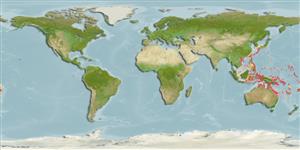>
Gobiiformes (Gobies) >
Gobiidae (Gobies) > Gobiinae
Etymology: Fusigobius: Latin, fusus = spindle + Latin, gobius = gudgeon (Ref. 45335); gracilis: Named for its being the most slender among its congeners..
More on author: Randall.
Environment: milieu / climate zone / depth range / distribution range
Ecologia
marinhas demersal; intervalo de profundidade 6 - 18 m (Ref. 41649). Subtropical
Western Pacific: Ryukyu Islands to the Great Barrier Reef and New Caledonia, east to Fiji.
Tamanho / Peso / Idade
Maturity: Lm ? range ? - ? cm
Max length : 4.2 cm SL macho/indeterminado; (Ref. 41649); 3.0 cm SL (female)
Descrição suscinta
Chaves de identificação | Morfologia | Morfometria
Espinhos dorsais (total) : 7; Raios dorsais (total) : 9; Espinhos anais: 1; Raios anais : 8; Vértebras: 26. Diagnosis: Dorsal rays VI - I,9. Anal rays 1,8. Pectoral rays 17-19 (usually 18). Longitudinal scale series 25. Head naked except for scales on side of nape reaching nearly to above upper end of preopercular margin; posterior nostril not close to orbit. The body is slender, depth 5.45-5.75 in SL; snout length 3.0-3.4 in head; first dorsal fin not higher than second; second dorsal spine usually longest, 5.35-5.8 in SL. Pelvic fins fully joined medially by membrane (when intact); pelvic frenum absent. Body translucent with numerous very small orange-yellow spots with blackish centers on head and body, those on head arranged in oblique rows; a black spot the size of pupil or smaller at midbase of caudal fin; a second smaller blackish spot just above base of pectoral fin; dorsal and caudal fins with orange-yellow spots; a dusky orange line from upper part of first membrane of first dorsal fin to base of second spine (Ref. 41649).
Inhabits sand-rubble bottoms next to reefs in 6-18 m (Ref. 90102).
Ciclo de vida ou comportamento de acasalamento
Maturities | Reprodução | Spawnings | Egg(s) | Fecundities | Larvas
Randall, J.E., 2001. Five new Indo-Pacific gobiid fishes of the genus Coryphopterus. Zool. Stud. 40(3):206-225. (Ref. 41649)
Status na Lista Vermelha da UICN (Ref. 130435)
Ameaça para os humanos
Harmless
Uso pelos humanos
Ferramentas
Relatórios especiais
Baixar XML
Fontes da internet
Estimates based on models
Preferred temperature (Ref.
123201): 24.9 - 29.3, mean 28.5 °C (based on 1509 cells).
Índice de diversidade filogenética (Ref.
82804): PD
50 = 0.5005 [Uniqueness, from 0.5 = low to 2.0 = high].
Bayesian length-weight: a=0.01023 (0.00477 - 0.02194), b=3.02 (2.84 - 3.20), in cm total length, based on LWR estimates for this (Sub)family-body shape (Ref.
93245).
Nível Trófico (Ref.
69278): 3.2 ±0.3 se; based on size and trophs of closest relatives
Resiliência (Ref.
120179): Elevada, tempo mínimo de duplicação da população menor que 15 meses (Preliminary K or Fecundity.).
Fishing Vulnerability (Ref.
59153): Low vulnerability (10 of 100).
